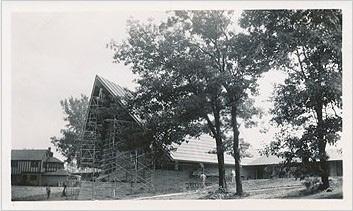
2 minute read
THE OAK TREES
Afew weeks ago, I found Mary Jane Hamilton’s 1991 book The Meeting House: Heritage and Vision on the extensive shelves at my parents’ house. It is an oddly-shaped book, longer than it is tall, with a folded cardstock cover the color of a paper grocery bag. Flipping through it, I looked at familiar images from FUS’s history: site plans, construction of the iconic prow, a group of men standing around a shovel at the ground-breaking ceremony, a group of women holding up the curtain they’d woven for the Hearth Room—the same curtain that now hangs in a glass case outside my office. There are pictures of the Stonehaulers—the women and men who helped transport a thousand tons of dolomite rock from a quarry outside Sauk City to our site in Shorewood Hills over the course of many weekends in 1949 and 1950. In the story of our congregation, we honor the Stonehaulers as our forebears, the people who with their own hands and determination built this church.
In his 1947 design for FUS, Frank Lloyd Wright called it “A Country Church for the Madison Unitarians.” Back then, this spot—now solidly in the middle of the city—was a rural suburb. Early visitors to the Meeting House report being able to see all the way to Lake Mendota. Hamilton writes: “In keeping with his vision of a rural church, Wright sought to preserve a nearby grove of oak trees where he hoped the parishioners would picnic after Sunday services, as he had in his youth with the Lloyd Jones family [...] near Spring Green.” Though I’ve long been familiar with Wright’s philosophy of organic architecture and site-based design, this was the first time
Advertisement
I’d encountered the idea that Wright specifically identified our oak trees as a part of his overall vision for the Meeting House.

Growing up at FUS, I loved our oak trees. In my CRE class called “Religion Without Walls,” our teacher and resident ecologist Brent Haglund encouraged us each to find our own sacred spot somewhere on campus; mine was in the wide, low branch of one of the old oaks north of the Loggia. (Recently Brent told me that some of the lower branches of the oaks needed to be cut down in the 90s because they “were killed by kids climbing on them,” and I had to confess that I was one of those kids!) In my family, my dad was the UU who brought us to church on Sundays, and my mom was a recovering Catholic who said that the only church she believed in was nature. Climbing into the oak tree and settling myself against its sturdy trunk, listening to the leaves whisper against each other while the adults were still inside the Landmark, I discovered a way to unite my parents’ theologies: I could be at church and in nature at the same time.
(con’t on page 11)







